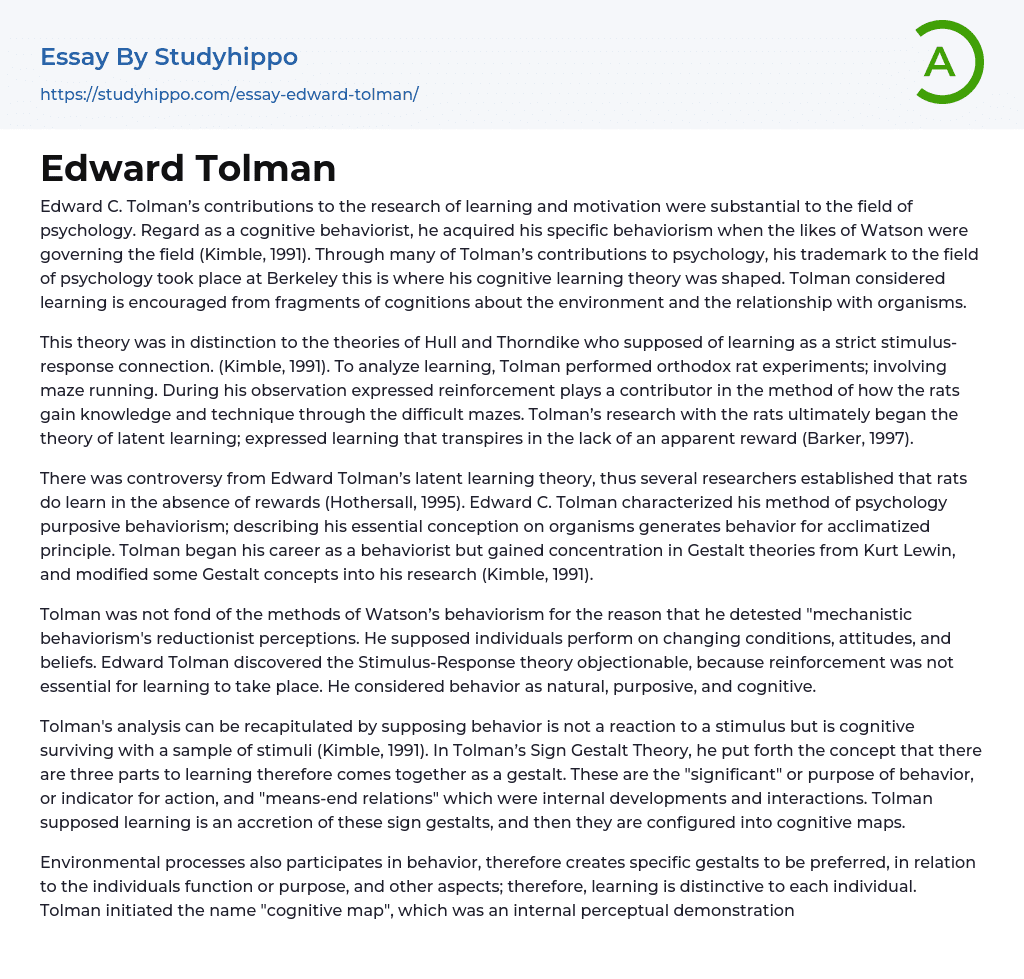Edward C. Tolman’s contributions to the research of learning and motivation were substantial to the field of psychology. Regard as a cognitive behaviorist, he acquired his specific behaviorism when the likes of Watson were governing the field (Kimble, 1991). Through many of Tolman’s contributions to psychology, his trademark to the field of psychology took place at Berkeley this is where his cognitive learning theory was shaped. Tolman considered learning is encouraged from fragments of cognitions about the environment and the relationship with organisms.
This theory was in distinction to the theories of Hull and Thorndike who supposed of learning as a strict stimulus-response connection. (Kimble, 1991). To analyze learning, Tolman performed orthodox rat experiments; involving maze running. During his observation expressed reinforcement plays a contributor in the method of how the rats gain knowledge and technique through the difficul
...t mazes. Tolman’s research with the rats ultimately began the theory of latent learning; expressed learning that transpires in the lack of an apparent reward (Barker, 1997).
There was controversy from Edward Tolman’s latent learning theory, thus several researchers established that rats do learn in the absence of rewards (Hothersall, 1995). Edward C. Tolman characterized his method of psychology purposive behaviorism; describing his essential conception on organisms generates behavior for acclimatized principle. Tolman began his career as a behaviorist but gained concentration in Gestalt theories from Kurt Lewin, and modified some Gestalt concepts into his research (Kimble, 1991).
Tolman was not fond of the methods of Watson’s behaviorism for the reason that he detested "mechanistic behaviorism's reductionist perceptions. He supposed individuals perform on changing conditions, attitudes, and beliefs. Edward Tolman discovered th
Stimulus-Response theory objectionable, because reinforcement was not essential for learning to take place. He considered behavior as natural, purposive, and cognitive.
Tolman's analysis can be recapitulated by supposing behavior is not a reaction to a stimulus but is cognitive surviving with a sample of stimuli (Kimble, 1991). In Tolman’s Sign Gestalt Theory, he put forth the concept that there are three parts to learning therefore comes together as a gestalt. These are the "significant" or purpose of behavior, or indicator for action, and "means-end relations" which were internal developments and interactions. Tolman supposed learning is an accretion of these sign gestalts, and then they are configured into cognitive maps.
Environmental processes also participates in behavior, therefore creates specific gestalts to be preferred, in relation to the individuals function or purpose, and other aspects; therefore, learning is distinctive to each individual. Tolman initiated the name "cognitive map", which was an internal perceptual demonstration of external environmental traits and impact. He considered individuals attain vast amounts of indications environmental and encourages presumptions regarding their stability or variable distinctiveness.
By exercises this internal image of a physical space they could get to the goal by knowing where it is in a compound of environmental aspects. Inconsistent routes and short-cuts are probable with this model. While behaviorists observation of preparation as a way to develop specified set of progression responses, Tolman contemplated that preparation would conduct inclination to go to a specified place; subjects would learn not only how to go, but where to go. Tolman acknowledged himself as a behaviorist and abstain from the nature of introspection that was observed by Titchener and Wundt.
justify">Conversely, he was also divergent to the behaviorism of Watson. He was recognized for initiating his personal approach to behaviorism which he referred to as "purposive behaviorism (Kimble, 1996). " His suggestion of purposive behaviorism involved determining the cognitive control of learning was not constrained to the evolutionary competency of the apes (Hilgard, 1987). Edward Tolman was a pioneer of psychology, today he is classified as a cognitive behaviorist and the discoverer of the cognitive theory.
Tolman’s perception of cognitive maps is still being used in the field of psychology. Cognitive maps were the basis to hypothesis of spatial thinking and memory (Hilgard, 1987). Edward Chase Tolman was comparable to the behaviorists in his prominence on impartiality and depth. His dissimilarity in that he had his doubts that reinforcement was required for learning to transpire. He credits a greater part of his contributions to the field of psychology to many of his students, his instructors at Harvard, and Kurt Lewin (Sahakian, 1976). Edward Chace Tolman
- Reinforcement essays
- Archetype essays
- Maturity essays
- Deception essays
- Certainty essays
- Conformity essays
- Aggression essays
- Behavior essays
- Human Behavior essays
- Obedience essays
- Adult essays
- Procrastination essays
- Morality essays
- Altruism essays
- Human Sexuality essays
- Role Model essays
- Perseverance essays
- Expressive essays
- Character Traits essays
- Apology essays
- Compassion essays
- Academia essays
- Higher Education essays
- Language Learning essays
- Studying Business essays
- Education System essays
- Study essays
- First Day of School essays
- Scholarship essays
- Pedagogy essays
- Curriculum essays
- Coursework essays
- Studying Abroad essays
- Philosophy of Education essays
- Purpose of Education essays
- Brainstorming essays
- Educational Goals essays
- Importance Of College Education essays
- Brown V Board of Education essays
- The Importance Of Higher Education essays
- Online Education Vs Traditional Education essays
- Academic And Career Goals essays
- Academic Integrity essays
- Brown Vs Board Of Education essays
- Distance learning essays
- Technology in Education essays
- Vocabulary essays
- Writing Experience essays
- Importance of Education essays
- Early Childhood Education essays


Unfortunately copying the content is not possible
Tell us your email address and we’ll send this sample there.
By continuing, you agree to our Terms and Conditions.


